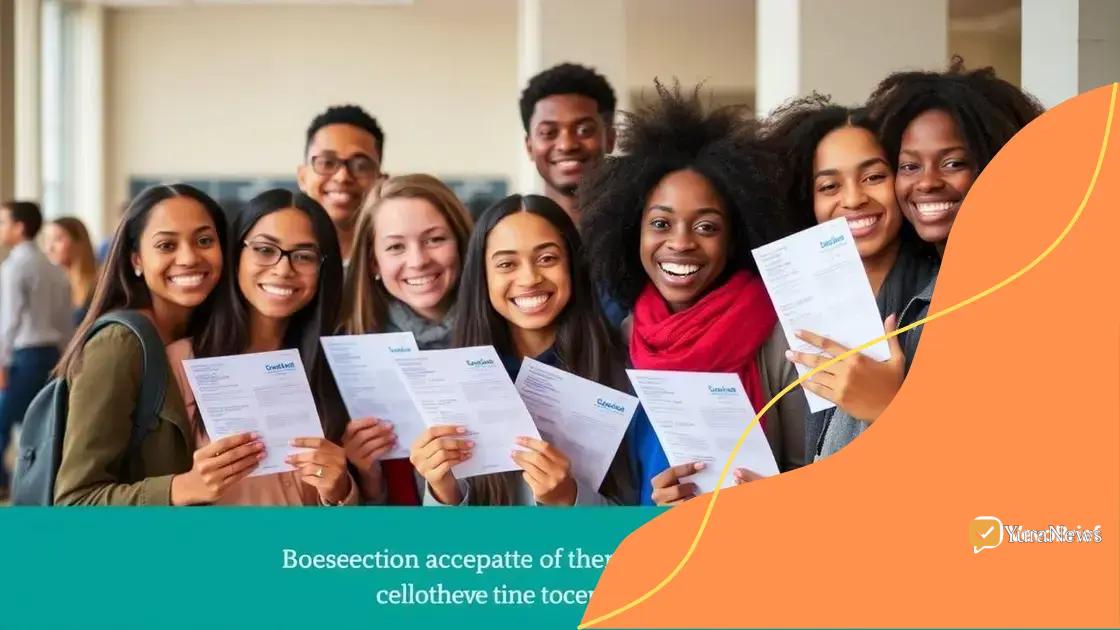FAFSA completion rates show slight improvement: what to know

Anúncios
FAFSA completion rates have shown slight improvement, enhancing student access to financial aid and increasing opportunities for higher education through better support and resources.
FAFSA completion rates show slight improvement, reflecting an encouraging trend for students applying for financial aid. But what does this really mean for you and your college journey? Let’s dive in.
Anúncios
Understanding FAFSA completion rates
Understanding FAFSA completion rates is vital for students and families navigating the college financial aid process. These rates reflect how many students complete the Free Application for Federal Student Aid, which is necessary for accessing financial aid. Recently, there has been a noted improvement in these rates, indicating a positive trend in students seeking assistance.
Factors Influencing Completion Rates
A variety of elements contribute to the changes in FAFSA completion rates. Socioeconomic status, access to information, and school support play significant roles. Here are some key factors:
- Increased awareness of financial aid options.
- Better support from schools and community organizations.
- Online resources and workshops that educate students and families.
Another aspect influencing completion rates is the availability of technology. With many processes being moved online, students can access the application anytime, making it easier for them to complete it. If they encounter problems, resources such as videos and FAQs provide immediate help.
Anúncios
The Role of Schools
Schools play a crucial role in improving FAFSA completion rates. Many have started implementing programs specifically designed to help students fill out the forms correctly. Engagement activities, including workshops and information sessions, can lead to higher completion rates. Moreover, the involvement of teachers and counselors can make a difference, as they can guide students through the often confusing application.
As these rates rise, it’s essential to continue providing support. Every increase in these figures can lead to more students receiving the financial aid needed to pursue higher education.
Factors driving recent improvements
There are several key factors driving recent improvements in FAFSA completion rates. Understanding these influences helps illuminate why more students are successfully applying for financial aid. By recognizing these elements, students and educators can better prepare and support one another throughout the FAFSA process.
Increased Outreach Efforts
Many schools and organizations have ramped up their outreach efforts. This includes providing workshops and information sessions that focus on the importance of completing the FAFSA. Increased visibility of financial aid resources helps students feel more informed and empowered.
- Schools send reminders and provide resources during crucial deadlines.
- Community organizations help families understand financial options.
- Online tools guide students through the application process.
Another significant factor is the collaboration between schools and local governments. By working together, these groups can offer targeted support. This collective effort ensures that students from various backgrounds receive consistent help, making a noticeable difference in application rates.
Online Resources and Technology
The advancement of technology has also played a vital role in improving FAFSA completion rates. The online application allows students to complete the FAFSA at their convenience. With mobile access, more students can apply without the constraints of time or location.
Furthermore, online resources such as tutorials and FAQs have emerged. These materials provide thorough explanations and help students troubleshoot any issues they encounter. By having immediate access to answers, students can quickly resolve confusion and move forward with their applications.
As these factors converge, the positive trend in FAFSA completion rates marks a crucial step toward greater accessibility in higher education. It’s essential to continue these efforts to ensure all students can secure the financial aid they need.
Impact of completion rates on student success

The impact of completion rates on student success is profound and wide-ranging. When more students successfully complete the FAFSA, it opens doors to various financial aids, scholarships, and grants that can significantly ease the burden of college expenses. This access not only helps students financially but can also contribute to higher enrollment and graduation rates.
Financial Access and Opportunities
With improved completion rates, students gain access to essential resources that empower them to pursue higher education without the stress of excessive debt. These financial aids help cover tuition, books, and living expenses, which can lead to lower dropout rates. Some of the specific benefits include:
- Increased enrollment in post-secondary institutions.
- Greater access to state and federal grants.
- More opportunities for scholarships based on financial need.
Moreover, students who receive financial aid through a completed FAFSA are more likely to complete their degrees. Financial stability allows them to focus on their studies rather than worrying about their financial situation.
Confidence and Retention
In addition to financial benefits, higher FAFSA completion rates impact students’ confidence levels. Knowing they have secured financial support can motivate students to stay in school and pursue their academic goals. This boost in confidence often translates into better academic performance, leading to higher retention rates.
Positive completion rates encourage a cycle of success, where students feel supported and capable of overcoming challenges. The clearer pathways provided by financial aid result in a more committed student body, fostering a culture of persistence and achievement.
Overall, as FAFSA completion rates improve, so do the prospects for student success. This trend is not just about numbers; it represents the promise of education for a brighter future.
Strategies for maximizing FAFSA submissions
Having effective strategies for maximizing FAFSA submissions is crucial for students seeking financial aid. By using the right approaches, students and families can ensure that they complete their applications accurately and timely, leading to more opportunities for funding.
Start Early
One of the best strategies is to start the FAFSA process early. The application opens on October 1 each year, and filing as soon as possible can provide better access to funds. Early submissions allow families to gather necessary documents without feeling rushed. Here are some steps to take:
- Begin collecting tax documents and financial information in advance.
- Set reminders for important deadlines.
- Encourage discussions about financial aid options early.
Starting early not only helps in gathering documents but also allows for corrections if needed before deadlines, which can be a common challenge for many.
Seek Help and Resources
Utilizing available resources is essential for maximizing FAFSA submissions. Many schools offer resources to support students in completing their applications. Students should reach out for help when needed. Options include:
- Public workshops at schools or community centers.
- Online tutorials providing step-by-step guidance.
- One-on-one assistance from school counselors.
Reaching out for help can alleviate the stress that comes with the application process. Understanding what to expect can lead to a smoother experience.
Additionally, staying organized throughout the process is vital. Keeping track of documentation and deadlines will minimize last-minute stress.
Use Online Tools
There are many online tools designed to assist with completing the FAFSA. For example, using the FAFSA app on a smartphone makes it easy to fill out the application on the go. Moreover, there are websites that offer checklists that guide users through each step, making them feel more secure in their submissions.
These tools provide valuable support that enhances confidence, leading to higher completion rates. By following these strategies, students and their families can increase their chances of maximizing FAFSA submissions, making financial aid more accessible.
Resources for helping students complete FAFSA
There are numerous resources available to help students complete their FAFSA. Utilizing these resources can make the application process simpler and less stressful for everyone involved. From online tools to in-person support, many options exist to guide students on their journey.
Online Resources
One of the most valuable resources is the Federal Student Aid website, where students can find detailed information about the FAFSA process. This site provides:
- Step-by-step instructions for filling out the application.
- Frequently Asked Questions (FAQs) addressing common concerns.
- Access to troubleshooting help for common issues.
Additionally, many educational websites offer tutorials and videos that explain how to complete the FAFSA effectively. These visual aids can be very helpful for students who learn better through demonstration.
Community Support
Support doesn’t just exist online. Schools and community organizations often host workshops to assist students with their applications. These hands-on sessions can greatly benefit students who need extra guidance. Often, local colleges and universities will provide:
- Workshops that walk students through the FAFSA process.
- One-on-one assistance from financial aid experts.
- Information about additional financial aid and scholarship opportunities.
Students should not hesitate to seek help from school counselors. They can offer personalized advice based on individual circumstances. Counselors have experience guiding students through the financial aid process, making them a reliable resource.
Peer Support
Students can also benefit from peer support networks. Friends or classmates who have completed the FAFSA can provide valuable insights and tips. Creating study groups or discussion sessions can help everyone involved stay motivated and informed.
By leveraging these resources, students can navigate the FAFSA process more confidently. With the right support and information, completing the FAFSA becomes a much less daunting task, paving the way for financial aid access.
FAFSA submissions is crucial for ensuring that more students can access the financial aid they need for college. With various resources available, students can find the help they require at every stage of the application process. From online tools to community support, these resources empower students to complete their FAFSA confidently. By starting early, seeking help, and utilizing available resources, students can unlock better opportunities for their education, leading to a brighter future.
FAQ – Frequently Asked Questions About FAFSA Completion
What is the FAFSA?
The FAFSA, or Free Application for Federal Student Aid, is a form that students fill out to determine their eligibility for financial aid for college.
When should I start my FAFSA application?
You should start your FAFSA application as soon as it opens on October 1 for the upcoming academic year to maximize financial aid opportunities.
What resources are available for FAFSA assistance?
There are many resources available, including school workshops, online tutorials, and counseling services to help students complete their FAFSA.
How can I improve my FAFSA submission rate?
To improve your FAFSA submission rate, start the process early, seek help when needed, and use online resources to guide you through the application.